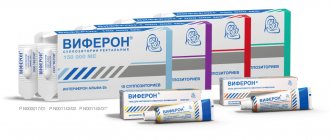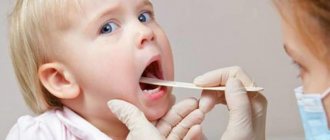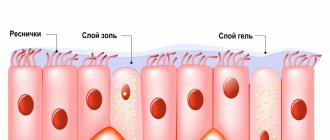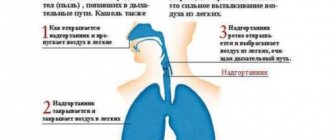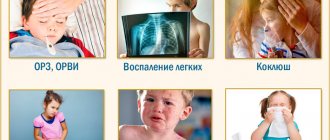Causes of sputum
In childhood, a cough with sputum always signals a disease occurring in the body. That is why mothers of babies should take the appearance of copious, difficult-to-cough mucus quite seriously.
Let us consider in detail the mechanism of sputum appearance. Normally, the body of a child aged 2-3 years secretes about 50 ml per day. mucus. Usually, such an amount, when it enters the nasopharynx, is simply swallowed unnoticeably.
Abundantly produced sputum is the body’s protective reaction to a disease occurring in the respiratory system. When pathogens enter the lungs and begin to actively multiply there, the baby’s immune system joins in the fight against them. She begins to produce a large amount of secretion with antibodies. In some cases, the amount of sputum produced per day in children may exceed 500 ml.
In children, the immune system is not well developed. Therefore, the mucus secreted by the child’s body does not contain many antibodies. The consequence of this is increased secretion.
If a child has a cough with sputum, then first of all it is necessary to diagnose the cause of the disease. The number of diseases that cause increased sputum production is very large. If we remove from this list diseases that are more characteristic of adults and diseases associated with pathologies of the respiratory system, then we can distinguish 3 diseases characteristic of childhood. These include:
- Bronchitis.
- Pneumonia.
- Asthma.
Let's look at these diseases in more detail.
Bronchitis
One of the most common infectious diseases in the world. This disease affects the bronchi. The first symptom of bronchitis is a cough. At first the cough is dry, then it becomes wet, deep, and paroxysmal. Mucus released when coughing can have different colors and consistency. The color can be from transparent to dark green, the consistency from liquid to thick mucus.
With bronchitis, mucus cannot be red. The presence of blood indicates a serious illness such as tuberculosis or a lung tumor.
Pneumonia
An acute infectious pulmonary disease in which the alveoli become inflamed. Occurs in childhood due to hypothermia and viral infection. With this disease, sputum is intensively produced on days 3-6 of the disease. In lobar pneumonia, the mucus coughed up is red in color.
Asthma
A chronic disease of the respiratory tract, characterized by attacks of suffocation, a feeling of tightness in the chest, and coughing. In asthma, thick and viscous mucus is formed, which over time can thicken and partially or completely block the lumen of the bronchi.
On this topic:
Causes of cough in newborns, treatment features
Causes of mucus in the throat
The causes of mucus in the throat are:
- Pharyngitis (inflammation of the pharyngeal walls);
- Sinunsitis (inflammation of the paranasal sinuses);
- Adenoiditis (inflammation of the pharyngeal tonsil).
All of these diseases cause mucus to accumulate in the throat. Increased mucus production in the throat occurs with nasal polyps and a deviated nasal septum. After nasal injuries, complications such as a forced cough may appear. Mucus in the throat often accumulates after a recent illness , such as the flu or ARVI. The cause of mucus in the throat may be a banal manifestation of bronchial asthma. With a disease such as bronchial asthma, mucus is formed in large volumes as a protective reaction of the body, being a means of evacuating allergens that leave the body in this way.
The accumulation of mucus in the throat can be caused by a carbonated drink, hot, spicy or very cold food. Nicotine and alcohol have such a detrimental effect, which irritates the mucous membrane of the nasopharynx, thereby aggravating the condition. All of these factors can cause congestion, which is manifested by a sensation of mucus accumulation in the throat. Most often, this symptom is observed in the morning after waking up. At night, mucus drains down the back of the throat and accumulates in the throat as a result of prolonged exposure to a horizontal position during sleep. Cough in the morning is not accompanied by changes in the lungs, but is characterized by frequent discharge of mucus clots.
Sputum in childhood
In childhood, there are some features of the body that can reduce the chance of independent sputum discharge in an infant.
Thus, children under the age of 1 year are mostly in an upright position. This is why mucus accumulates very well, but leaves with great difficulty.
The antitussive reflex is poorly developed, the child cannot yet cough strongly. Therefore, mucus begins to accumulate and comes off with difficulty.
The muscular system of infants is underdeveloped, so coughing does not involve the intercostal muscles and diaphragm. Due to this, the cough is weak and the baby cannot clear his throat.
If a child cannot cough up mucus for a long time, you need to know how to thin the child’s mucus.
Treatment options
In this section, we will not describe methods for treating specific diseases, but methods for getting rid of phlegm, which is a symptom of these diseases. So, there are several proven ways to remove phlegm from a child’s lungs.
Here are the main ways to get rid of cough with phlegm in a child:
- Drug treatment.
- Massage and inhalation.
- Traditional methods.
Complex therapy is often used, using all the treatment methods indicated above. Therefore, if you are wondering how to quickly remove phlegm from a child’s lungs, you can try a combination of all treatment methods.
Drug treatment
This type of treatment is aimed at two factors that facilitate treatment:
- Reducing the amount of sputum produced.
- Reducing the viscosity of sputum so that the baby can cough it up more easily.
Young children are mainly prescribed drugs based on medicinal herbs and rarely their synthetic analogues. For children under one year old, Gedelix and Ambroxol syrup are suitable. They gently dilute mucus and improve its removal from the lungs.
Another remedy recommended from birth is Bromhexine syrup. This drug enhances the work of the ciliated epithelium, the cilia on the surface of the bronchi begin to more actively remove mucus towards the respiratory tract.
Prospan syrup is also often prescribed to infants. Created on the basis of ivy leaves, the drug has proven itself in pediatric practice. It is often prescribed by doctors when they hear the question of how to remove phlegm from a baby.
For children aged 1 to 3 years, ACC can be taken. This is a synthetic medicine based on acetylcysteine. It is very effective in clearing up difficult to cough up mucus.
Fluditek is also an effective remedy for children aged 1 to 3 years. This drug is effective because it helps remove phlegm in a 1-year-old child due to the fact that it destroys disulfide bonds in the sputum. This action leads to the liquefaction of mucus and easy removal from the bronchi.
Children aged 3 years and older are often prescribed Pertusin. It has been known for decades and has established itself as a universal remedy when a child has a lot of phlegm when coughing. The syrup is based on medicinal herbs, but due to the ethanol content it requires dilution with water when taken.
On this topic:
How and with what to treat a wet cough in a child, medications and traditional methods
Another effective remedy for children aged 3 years and older is Amtersol syrup. Contains licorice and thermopsis extracts. Usually prescribed after meals three times a day.
Massage and inhalations
Let's take a closer look at the massage technique that is used when a child's cough with phlegm intensifies. A simple and effective type of massage is drainage. Designed to remove excess mucus from the lungs.
The essence of this massage is that, when performed correctly, the so-called “bronchial tree” warms up. This tree represents the area of the respiratory system in which the bronchi are located. Due to heating, the liquid in the small bronchi begins to liquefy, flows into the larger bronchi, from where it enters the trachea and comes out with a cough.
Massage movements also help activate the ciliated cilia, which are located on the surface of the bronchi. When moving, they capture mucus and move it to the exit of the bronchi. Therefore, if parents are wondering how to remove phlegm from a baby, then you can try this massage.
The procedure for this massage is as follows:
- Place the baby on his tummy. In this case, the head should be located slightly below the thoracic region. The ideal location is on a pillow lying on the massage therapist’s lap.
- Using gentle warming movements, rub the entire back of the baby from the lower back to the shoulders. Rub in the direction from the lower back to the head.
- After the back turns a little red, you can begin light tapping in the lung area, alternating with light tingling. You can tap with your fist and the inner edge of your palm.
- Rub the baby's chest, avoiding active movements in the heart area.
After the massage, the child should not become hypothermic and should be offered plenty of fluids.
Massage is contraindicated at high temperatures.
Inhalations are quite effective. This is due to the fact that the active substance is delivered directly to the lungs, bypassing the circulatory system and without having a negative effect on the gastrointestinal tract.
We will not consider inhalation over a pot of potatoes. We classify this type of inhalation as a folk method. In the context of inhalations, we will consider carrying out this procedure using a nebulizer.
There are different groups of solutions that have a positive effect. They are designed to alleviate the situation when a child has a lot of phlegm. Let's look at these groups in more detail:
- Saline solutions. This includes saline solution, Sialor Aqua, and some types of mineral water sold in pharmacies. The action of these solutions is based on the ability to thin mucus and moisten the airways to provide relief.
- Alkaline solutions. Mineral water such as “Borjomi” or “Essentuki”. Such solutions relieve swelling of the lungs and promote the separation of mucus from the walls of the bronchi.
- Bronchodilators. These are drugs such as Berodual, Ventolin and some others. They relieve pulmonary spasms and make breathing easier.
- Mucolytics. These include “ACC”, “Fluimucil”. Inhalations with them reduce the viscosity of sputum, diluting it.
- Mucokinetics. These are drugs such as Lazolvan, Ambrobene. These drugs activate the work of cilia on the surface of the bronchi, due to which the mucus begins to move more actively towards the trachea and respiratory tract.
Syrups taken orally are not suitable for inhalation.
Traditional methods
We would like to warn you that traditional methods of treatment should not replace the treatment prescribed by a doctor. The use of even the most common medicinal herbs can cause unexpected consequences for the baby.
On this topic:
How to help your child relieve cough at night
Therefore, use should be careful, careful, with mandatory observation of the baby’s reaction. Among the most popular folk treatment methods used when a child cannot cough up phlegm are the following:
- Rubbing the back and chest with the “Golden Us” product.
- Rubbing your feet with a mixture of raw garlic and butter.
- Take three drops of almond oil three times a day after meals.
- Inhaling the vapors of freshly boiled potatoes.
- Use an infusion of plantain, coltsfoot, and licorice root brewed in equal proportions.
Cough with sputum - causes
Most often, a severe cough with sputum in childhood indicates a pronounced picture of an acute inflammatory process in the upper or lower respiratory tract. In an infant, the cause of cough is alveolitis, in an older child it is tracheitis, bronchitis, pneumonia.
The causes of cough with sputum in adults are more extensive and varied:
- Nasopharyngeal drip is one of the most common causes of prolonged cough. Mucous discharge flows from the swollen paranasal sinuses along the back wall of the pharynx (mainly at night), reaches the vocal cords, irritating the receptors. In the morning, the cough is fully manifested due to the accumulation of sputum in the pharynx and larynx. Postnasal drip is characteristic of allergic manifestations.
- Smoking. Nicotine tars settling in the lungs provoke hyperproduction of mucus, which entails the following protective mechanism: by constantly persistent coughing throughout the day, the body tries to get rid of the poison diluted with sputum.
- Infections. Bacteria, viruses, protozoa, fungi - all of them are a trigger for the onset of an inflammatory reaction. The infection begins with inflammation of the pharynx (pharyngitis) and can progress to severe bronchitis or pneumonia. The disease is characterized by high fever, hoarseness, coughing in the evening and at night.
- Bronchial asthma is a disease of the bronchi, accompanied by coughing, suffocation, and difficulty breathing. The trigger mechanism for an attack is mainly allergens.
- Abscess (ulcer) in the lungs, suppurative process in the bronchi (bronchiectasis). A persistent cough is an opportunity to get rid of the accumulated purulent contents of the lacunae.
- Oncological diseases (cancer, sarcoma) of the respiratory system occur with pronounced symptoms. This includes coughing with viscous and foul-smelling sputum.
- Tuberculosis. A muffled cough is accompanied by night sweats, and streaks of blood are found in the discharge.
- Pleurisy. Inflammation of the pleura leaves a hectic temperature and a productive cough with foamy discharge.
- A foreign body entering the windpipe irritates the receptors and causes constant choking.
- Gastroesophageal reflux disease, reflux, inflammation of the esophagus. Problems with the stomach, esophagus or duodenum lead to a pathological return of eaten food back into the throat, causing chronic inflammation of the mucous membrane. As a result, the patient is bothered by periodic choking.
- Complications of diseases of the cardiovascular system (hypertension, heart failure, diffuse cardiosclerosis) are manifested by coughing.
- Drugs of the ACE inhibitor group. The antihypertensive drug promotes the production of bradykinin, a peptide that provokes the cough reflex.
Useful tips
Increase the humidity where the baby is. This is especially true in winter, when central heating dries out the air. Normally, humidity should be from 45% to 60%. This humidity is difficult to achieve by simply hanging wet things around the room. Therefore, it is advisable to purchase a specialized humidifier.
If a baby has a cough with phlegm, then it’s time to start giving him water to drink, if you have not already started doing this. An additional portion of fluid will help reduce the viscosity of sputum and improve its discharge.
If a small child coughs and produces a lot of phlegm, you can rinse the nose with salt water or saline. This will help avoid drying out the mucous membrane.


